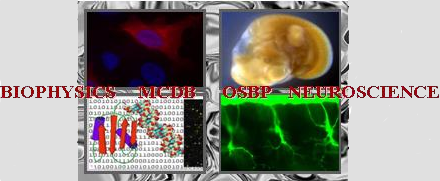Poster abstracts
Poster number 23 submitted by Brandon Crowe
Structure of the Brd4 ET domain bound to a C-terminal motif from γ-retroviral integrases reveals a conserved mechanism of interaction
Brandon L. Crowe (Ohio State Biochemistry Program), Ross C. Larue (College of Pharmacy, The Ohio State University), Chunhua Yuan (Campus Chemical Instrument Center, The Ohio State University), Sonja Hess (Proteome Exploration Laboratory, California Institute of Technology), Mamuka Kvaratskhelia (College of Pharmacy, The Ohio State University), Mark P. Foster (The Department of Chemistry and Biochemistry, The Ohio State University)
Abstract:
Retroviruses must integrate their reverse-transcribed DNA into host chromatin in order to replicate. Sites of retroviral integration are not random and vary by retroviral genera. For example, γ-retroviruses such as murine leukemia virus (MLV) target transcription start sites. This preference is mediated through interactions between retroviral integrases (IN) and a host transcription factor protein family the bromodomain and extraterminal domain (BET) epigenetic reader proteins. The BET family contains two N-terminal bromodomains, which bind acetylated lysines that mark histones at transcription start sites, and an extraterminal (ET) domain which normally functions to recruit epigenetic modifying enzymes to chromatin. MLV IN binds the ET domain through a short conserved C-terminal motif we have named the ET binding motif (EBM). We used isothermal titration calorimetry (ITC) to show a tight interaction between the short MLV IN EBM and the Brd4 ET domain. We then used NMR to determine the solution structure of the Brd4 ET domain in complex with the MLV IN EBM. The structure reveals the formation of a three stranded antiparallel β-sheet, with two strands from the MLV IN EBM and one strand formed by structuring a loop in the ET domain. The structure reveals the formation of a hydrophobic core on one face of the β sheet and electrostatic interactions on the other face. Lastly, we have mutated the key residues on the Brd4 ET domain and studied the effect of these mutations on the ability of Brd4 ET to bind other transcription factors. Our data strongly suggests that the interaction characterized here mimics the cognate interactions relevant for the recruitment of other human transcription factors.
References:
Larue, R. C., Plumb, M. R., Crowe, B. L., Shkriabai, N., Sharma, A., Difiore, J., Malani, N., Aiyer, S. S., Roth, M. J., Bushman, F. D., Foster, M. P., and Kvaratskhelia, M. (2014) Bimodal high-affintiy association of Brd4 with murine leukemia virus integrase and mononucleosomes. Nucleic acids research. 42(8): 4868-81. doi. 10.1093/nar/gku135.
Crowe, B.L., Larue, R.C., Yuan, C., Hess, S., Kvaratskhelia, M., Foster, M.P. (2016) Structure of the Brd4 ET domain bound to a C-terminal motif from γ-retroviral integrases reveals a conserved mechanism of interaction. Proc. Natl. Acad. Sci. USA. 113(8): 2086-91. doi. 10.1073/pnas.1516813113.
Keywords: Retroviruses, BET transcription factor family, NMR solution structure
